How to heal your shoulder by working around it
12When a new student comes to see me about her shoulder pain, the first thing I usually ask her to do is LEAVE HER SHOULDER ALONE. This might seem a bit counter intuitive. When some part of the body starts hurting, the first instinct for many yoga practitioners is to “work it”. Yet often it is NOT the shoulder joint itself that’s the problem. The shoulder often ends up on the receiving end of what’s happening elsewhere in the body; namely the chest, upper and middle back. So we need to stop stretching the shoulder with intricate Cow Face-like maneuvers and stop trying to strengthen it with challenging weight-bearing poses. When we intend to work with the shoulder discomfort we usually have three main objectives:
1. Figure out what is causing the problem. I talk a lot about how repetitive movements that we do in our daily lives can cause problems over time or prevent vulnerable areas from healing. That is why the first thing we need to do is analyze our movement patterns and notice what could be contributing to the shoulder problem. Then we need to eliminate those triggers or modify them.
2. Stretch and strengthen the muscles that bind the shoulder girdle to the spine and the ribcage. As we discussed earlier, the shoulder joint does not exist in isolation. It is a part of the shoulder girdle that sits on top of the ribcage and is attached to it (and the spine) via complex network of muscles and connective tissue. When we develop tension or any sort of imbalance in those structures, they can pull the shoulder out of alignment and cause pain. That is why we need to restore balance AROUND THE SHOULDER GIRDLE by strengthening what’s weak and releasing chronic muscular tension.
3. Mobilize the shoulder. The last step would be to gradually increase the range of motion in the shoulder over time. We usually do it via repetitive motion, rather then static stretching to follow the contract-relax-stretch principle.
The practice below addresses shoulder discomfort by working with the chest and upper back, neck and middle back instead of the shoulder joint itself. We certainly move the arms, which has an effect on the shoulder, but the movement is always initiated in the center of the body and then extends out into the periphery (limbs).
Please make sure that you do not take it too far too soon. If you have acute shoulder pain, it would be better to pick 2-3 poses and stick with those at first, and then gradually add more as the shoulder begins to feel better. The “no pain, no gain” philosophy does not work here: if you feel pain, limit the range of movement or stop altogether and try another pose. Make sure to breathe deep and initiate every movement from the center.
Join Sequence Wiz to customize this practice to your liking. Choose your poses, enter the instructions and you are done! See it in action >

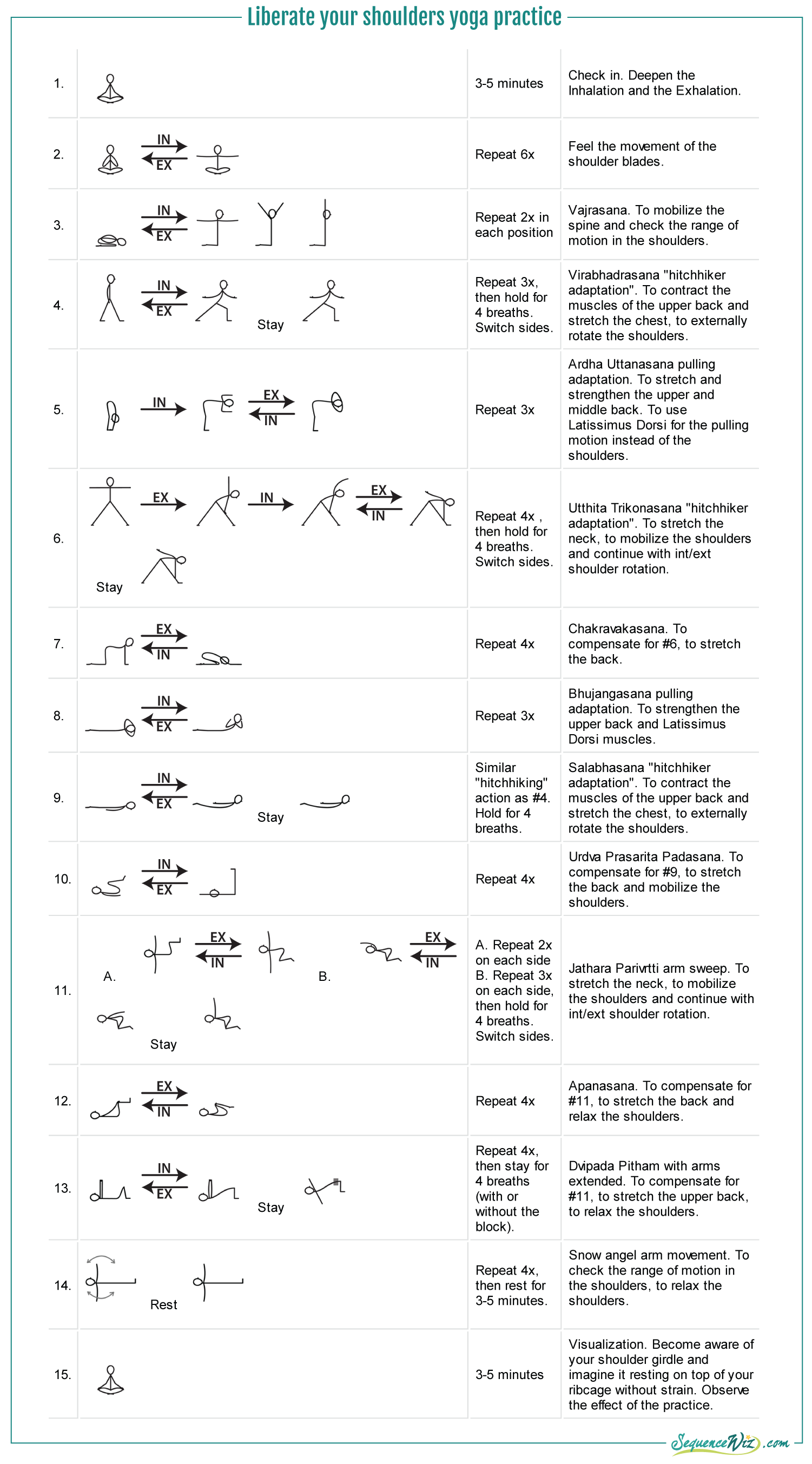

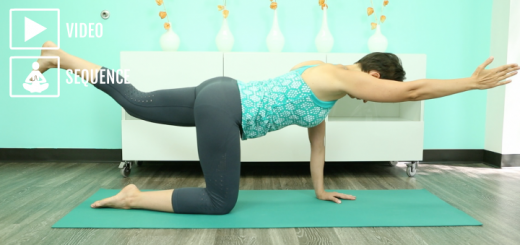
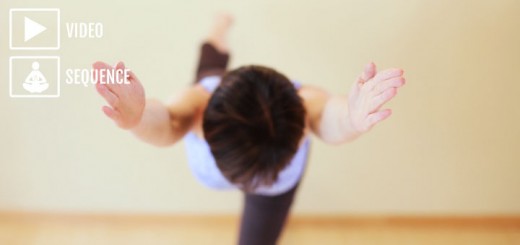
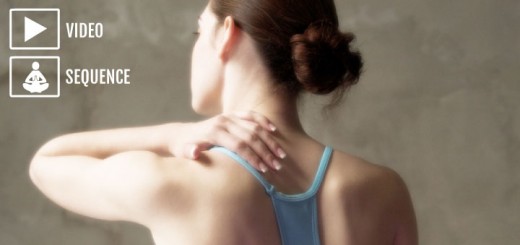
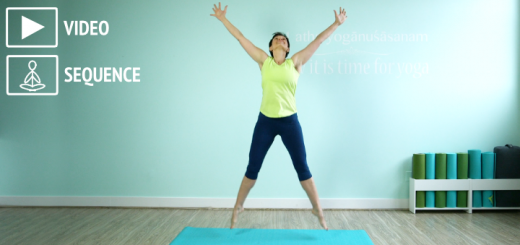















Woderful class, love it and will definetly do it again. I feel liberated… thanks for this
Tamar
Thank you so very much Olga !!!!
Wow – this is great! My shoulders feel so much better. Thanks!
First THANK YOU for all of your classes + information, I have 1 ?/clarification
In cobra with external rotation the arms, you say to use your lat’s however the Latissimus dorsi muscles connecting the upper extremity to the vertebral column, adducts, extends and internally rotates the arm, it’s a powerful internal rotator that tends to take over + round the shoulders when what we want is external rotation
The Infraspinatus and teres minor muscles on the back of the shoulder blades these 2 rotator cuff muscles externally rotate the arm along with the help of rhomboids, middle trap’s.
Love your classes and information on your site Olga!
As a teacher in the Krishnamacharya tradition, I find your instructions clear and simple and I often direct my students to your site.
Bravo.
I go to your videos when I need a class for my own practice 🙂
This has been great for my shoulder “issues”, so I hope to practice it more.
Thanks so much.
Dear Olga,
I would like to thank you so much for this incredible website and the excellent resources that you share. Your materials and input have given me new inspiration and enthusiasm for teaching yoga, I can’t wait to come how and read or study or teach…! This is the kind of continuing education that I was looking for, I so appreciate the quality and care with which you do everything. THANK YOU!!!*****
Thank you so much Monica, your comment warms my heart! I am so happy to hear that my writing helps you spread the light of yoga out and wide! 🙂
Olga, thanks for your helpful articles! Do you have any suggestions for someone who is unable to move one of their arms (i.e., due to paralysis after an injury)? Thank you!
Hi Beth! This is definitely a tough situation, so we just need to figure out what IS possible. If the arm movement is not possible, how about shoulder movement (up-down, forward-back, circular)? Our goal is to move the shoulder blade, so we can work on that. Also, in many movements, especially side-bending and twisting, the areas around shoulder blades get engaged even if you don’t move the arms, so you can experiment with those. And finally, research shows that when you imagine doing a movement the same parts of the brain fire up as if you were actually doing it (may be not with the same intensity, but still). So intentionally envisioning the arm movement with breathing can be an excellent exercise both for the body and the mind. Hope this helps!
Once again, Olga, you are absolutely amazing! I can’t believe you have two sequences devoted to healing specific injuries and you hit mine spot on in both! Thank you so much for making your wisdom available to us over the internet. I don’t know where I would be without you.
Olga! Olga Olga Olga!!!!!
I am so excited to tell you that my shoulder is healing because of your practice! Today, for the first time, I was able to perform #11 without a hitch. I injured my shoulder in May, probably in a bicycle crash, and I developed this catch where certain positions were painful, but I couldn’t identify where the pain was coming from, or if it was a muscle or what was causing it. I discovered this practice about two months ago and I’ve been doing it once or twice a week since. I always feel like I have better motion in that shoulder on days that I do the practice, but the sharp pain stayed with me.
Until today! Today I can move my shoulder where it needs to move and I don’t hurt! I NEVER heal from injuries, they only fade into the distance when I stop using my body, but come back when I start again. But today I feel like I am healing.
Thank you! thank you!
Hi Pinkie, I am so excited to hear that! Yey! Kudos to you for sticking with the practice and I am so happy that your shoulder responded! My teacher always says that change is inevitable in life, but yoga gives us a chance to affect the direction of change. You just did! Hopefully your shoulder is now set on path to full recovery. Good work!